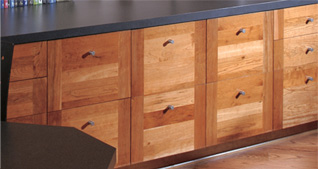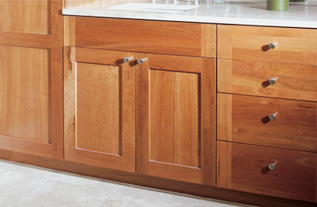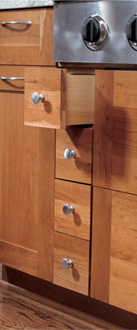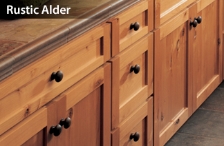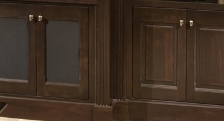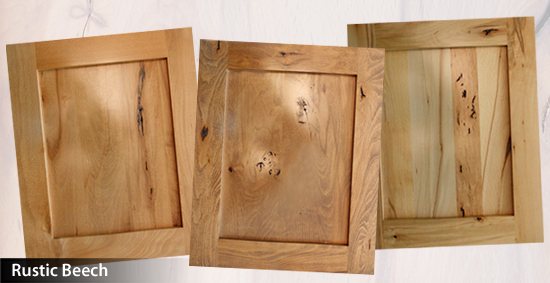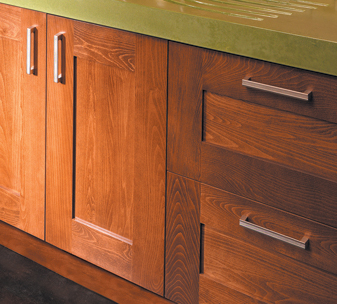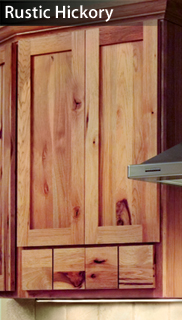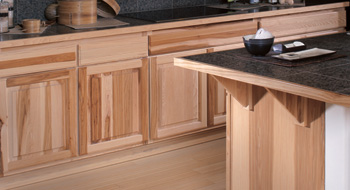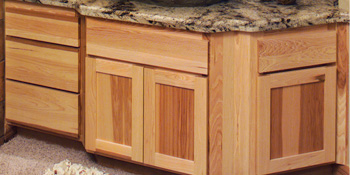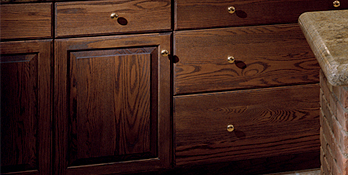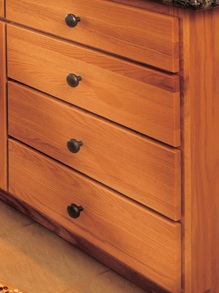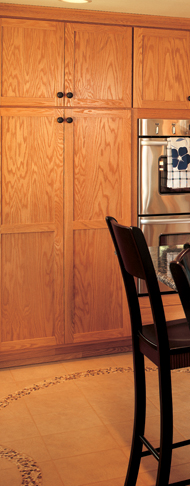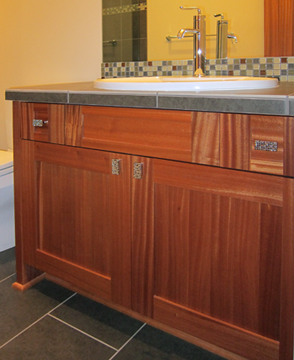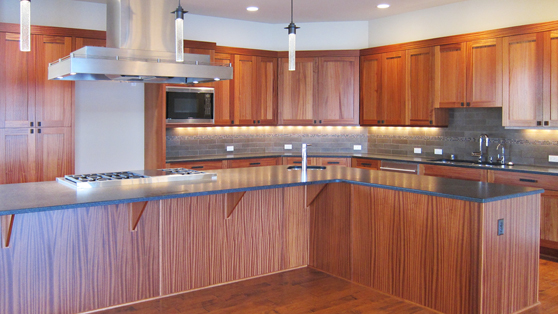Wondering what type of wood you'd like for your new kitchen? What would look best for your office? Should you use paint or stain? Let's start with some of the most popular woods being used today; then we'll bring you samples.
Maple is a stiff, strong heavy wood with a tight, uniform grain pattern and a smooth surface. Characteristics include burled grain, pin knots and caramelizing. Maple varies in color from nearly white to yellow, pink, light purple and slightly reddish brown. The smooth, even surface of maple makes it the wood of choice for paint and stains.
Rustic Maple is also hard, but features a random blend of natural characteristics. A range of grain patterns and colors may appear on the same panel, and adjacent door and drawer fronts may not match each other. These are natural traits of maple and are not considered a defect.
Cherry is moderate in hardness, weight, and strength, with a fine to medium grain pattern and a relatively smooth surface. Characteristics include gum spots, pin knots and sapwood. Colors vary from off-white to light red to a dark, reddish brown. Light-sensitive cherry will mellow as it ages, and will take on a rich patina with exposure to sunlight and day-to-day use. Over time, cabinets in different areas of the same room may appear quite different due to light exposure.
A range of grain patterns and colors may appear on the same panel, and adjacent door and drawer fronts may not match each other. These are natural features of cherry and are not considered a defect.
Alder is a moderately light and slightly soft hardwood, with a smooth surface and very little grain showing. Alder may display pin knots, grain "fuzz" and mineral streaks. Colors may vary from almost white to tan and pale, pinkish brown, with differences being accentuated when clear, light stain colors are used.
Rustic Alder shares the same attributes as alder, and features a random blend of natural characteristics. Just as with rustic maple, a range of grain patterns and colors may appear on the same panel, and adjacent door and drawer fronts may not match each other. These are natural qualities of alder and are not considered a defect.
Beech is a plentiful, sustainable, carefully managed species. It is a hard, strong, durable wood with a fairly straight grain pattern and a relatively smooth surface. Knots and irregular grain may be present, but are generally kept to a minimum. Colors vary from light to mid-tone brown, with some dark brown heartwood streaks.
Rustic Beech shares the same attributes as beech, and features a random blend of natural characteristics that occur much more frequently than in beech. When light to medium-colored stains are used, grain patterns and ray flecks will be more prominent. Darker stains will subdue the color variations and enhance the grain pattern. A range of grain patterns and colors may appear on the same panel, and adjacent door and drawer fronts may not match each other. These are natural characteristics of beech and are not considered a defect.
Hickory is a very heavy, hard and dense wood. It is known for its "mild to wild" color characteristics and offers a bold, prominent grain pattern and burls, water stains, and knots. Colors often vary strongly in the same board from nearly white to dark brown! Keep in mind that adjacent door and drawer fronts can appear radically different from each other, with the "mild" one having a fairly consistent grain and color distribution and the "wild" one showcasing three different colors. This is considered normal and is not in any way a defect.
Red Oak is a dense, heavy wood that is very hard, with an open grain pattern and textured surface. Many characteristics show, including mineral streaks, ray flecks, and pin or closed knots. Red Oak ranges in color from white and cream to a warm, pale brown, tinted with red. The bold grain and subtle-to-rich color ranges provide the character Red Oak is known for. A range of grain patterns and colors may appear on the same panel, and adjacent door and drawer fronts may not match each other. These are natural characteristics of Red Oak and are not considered a defect.
Quarter-Sawn Oak. Stable wood with pale yellow-brown to pale brown tones, sometimes with a pinkish tint. As a result of the quarter sawing process, the wood exhibits a beautiful grain texture with a uniform straight grain and a striking ray flake figure. You can expect occasional pin knots and light mineral streaks.
Beautiful, exotic Sapele is an African hardwood similar to - and often used in place of - Mahogany. Sapele features interlocking, fine-textured grain that frequently changes direction. Quarter Sawn Sapele creates a ribbon or stripe effect, almost as if the wood glows with an internal light. Colors range from light brown to medium reddish brown tones. Sapele is light-sensitive, and will darken with age, an effect that will be accelerated with exposure to sunlight. A range of colors and grain patterns may appear on the same panel, and adjacent door and drawer fronts will not match. These are natural characteristics of Sapele and are not considered a defect.
Click here to watch a short video about Sapele.



